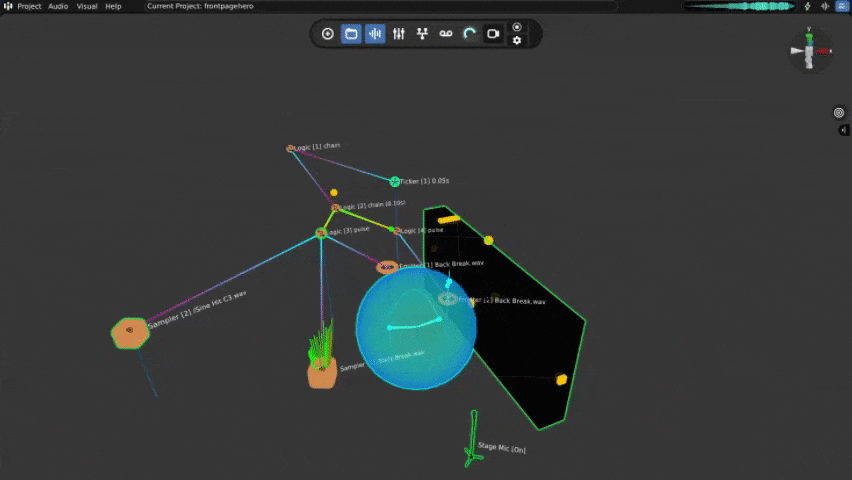How to Write Ambient Music: A Guide to Space and Texture
Ambient music is a uniquely powerful genre. At its best, it can evoke deep emotion, create entire worlds with sound, and alter the feeling of the space you're in. But for producers trying to capture that magic, the path can be elusive.
So, what are the fundamental compositional techniques you need to produce compelling ambient tracks? And in a world of endless plugins and synths, how can modern tools help you realize your vision without getting in the way of your creative flow?
The secret lies in shifting your perspective. Great ambient music is about the intricate connection between sound and space. The space isn't just a container for the music; the space is the music.
In this article, we are going to look at the core principles of ambient music, the challenges you might face creating ambient music in a normal DAW, and how you can use Audiocube to create ambient music in the right space.
In This Article...
You will learn what ambient music is and what key features make up ambient music.
Why some of the traditional DAWs are not necessarily the best workstations for creating ambient music.
I will show you how you can use the core features to create your own ambient music.
Audiocube is a great software for creating ambient music in an immersive space.
What are the Core Principles of Ambient Composition
The term ambient music was famously popularized by Brian Eno, who envisioned a type of music that could be "as ignorable as it is interesting," and can be thought of as furniture music - it blends into the background.
Ambient music doesn't demand your full listening attention like many other genres, yet it rewards it with deep, evolving detail, and it can have an effect on moods. It borrows from minimalism in classical music and experimental sound design to create something entirely new.
Texture Over Melody: While harmonic elements are often present, the primary focus is on the timbral quality of the sound. The delicate crackle of noise, the granular clouds from granular synthesis, or the organic feel of real instruments and everyday sounds are all vital ingredients.
Slow Change and Evolution: An ambient song rarely sits still; it's about slow change and subtle shifts in timbre, position, and density that occur over long periods. This creates evolving atmospheres that keep the subconscious mind engaged. A listener might not consciously hear a sound moving over the course of a minute, but they will feel the atmosphere shift.
Generative Patterns: Rather than relying on simple loops that can become repetitive, many ambient artists use generative techniques. This involves setting up systems where new elements and patterns can emerge organically, creating a non-repeating and endlessly interesting experience for the listener.
Space as an Instrument: Space is a primary compositional element in ambient music. You don't just play a synth; you play a synth inside a vast, virtual space, and the sound of that space becomes part of the instrument itself. The environment and the sound source blend into one.
What is the Challenge of Creating Space in a Normal DAW
Given that space is so fundamental, it’s ironic how difficult it can be to create a natural and unified sense of it in a traditional DAW; the typical process is often fragmented and technical.
The workflow usually looks something like this: You load up your favorite synths on several tracks, find some audio samples or vocals to layer sounds in. You set up multiple reverb and delay sends, trying to create different layers of depth and use complex automation on high and low volume and panning techniques to add movement. You might apply a low pass filter here to push something into the background, or gently filter high frequencies on another sound.
The biggest challenge with this method is that it’s disjointed; you're managing a dozen different plugin windows. It's difficult to get a holistic sense of the sonic landscapes you're building when you're focused on the technicalities of pre-delay times and bus routing. The entire track can feel less like a unified whole and more like a collection of separate parts swimming in a sea of effects.
How to Use Audiocube as a Compositional Tool for Ambient Tracks
Audiocube can be used as a tool to create, explore, and experiment with ambient music in an immersive, virtual space. You can build your track in 3D and make your ambient music more effective and realistic, similar to how we naturally hear sounds in everyday life.
How to Design Your Sonic Space Visually to Create Ambient Music
To overcome these challenges, we need a tool that treats the creation of space as a primary, intuitive act. Audiocube is more than just a mixing plugin; it's a complete compositional environment for ambient artists, designed to make building atmospheric textures visual and immediate.
Your primary instrument is the Acoustic Simulation engine. Before you even think about what notes to play, you can design the character of your space. You define the sonic signature of your environment first. This single feature becomes the unifying force for the entire track, ensuring that all other sounds and elements exist cohesively within the same world.
Once your space is defined, you can focus on creating that essential slow change with Spatial Automation. This feature is at the core of crafting evolving atmospheres. Instead of drawing fiddly automation lanes for panning and volume, you can draw a three-dimensional path for any sound.
For creating generative patterns, the Emitter virtual device is a perfect tool. You can load a simple sound, a bell tone, a snippet of noise, or a fragment of a field recording into the sampler, and the Emitter will generate random particles of this sound within the 3D space.
You can control the rate, lifetime, and movement of these particles, creating ever-changing, non-repetitive textures that would be difficult to program manually. It’s a brilliant way to introduce new elements that feel organic and alive.
How to Create Ambient Music With Audiocube
Let's walk through a practical workflow that puts these principles into action. This approach moves away from traditional song structures and embraces a more architectural method of building sound.
Download Audiocube - You can download Audiocube for free on both Mac and Windows or for the full features, you can purchase a lifetime license.
Create a New Project and Import Tracks - Create a new project and import your tracks. You can use your own samples, like an electric guitar, or download Audiocubes' sample pack.
Insert a Sampler - Add a sampler tool to your project and choose a sound that works for you.
Place your Sound in a 3D Space - Change the placement of your sampler within Audiocube's virtual world wherever you like. This is useful if you want to bring more structure to your mix.
Mix and Add Some Additional Effects - Within the mixing tab of Audiocube, you can find access to EQs to remove higher or lower frequencies, a compressor, and other effects.
Experiment with your Acoustics - Add sound walls to your project and place them near your samplers, and you will see natural reflections of the sounds. If you want to hear 360° sound in your headphones, just turn on the HRTF binauralizer.
Finalize and Export your Mix - Once you're happy everything has the right placement, you can add mastering effects to secure your mix together and then export your mix to a WAV file.
Audiocube makes making ambient sound easy. Follow the above steps, and you can start working on your second track and much more.
You can try this for yourself and start creating ambient music. Download Audiocube or buy a lifetime license for access to the full features.
Start Making Ambient Music with Audiocube
To write great ambient electronic music, you need to think like an architect, not just a musician. The most moving ambient tracks are not built from complex melodies or chord progressions but from carefully constructed spaces.
Ready to start building your own sonic worlds? Download a free trial of Audiocube or purchase a full license and discover a new way to compose ambient music.





